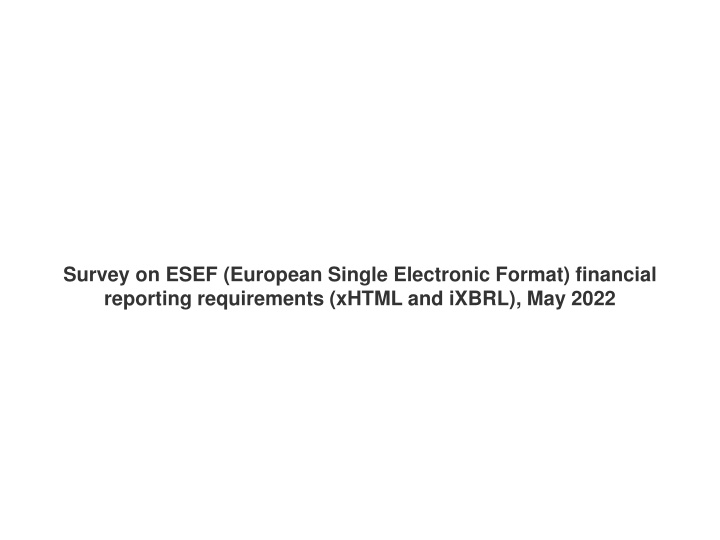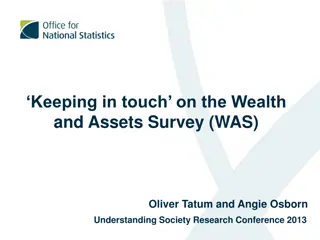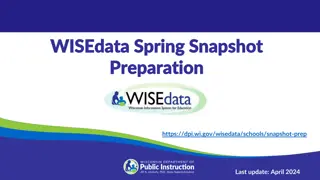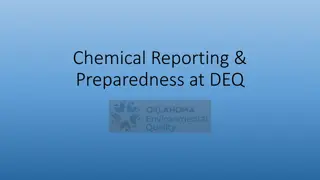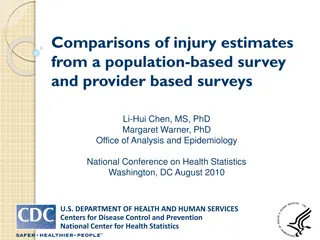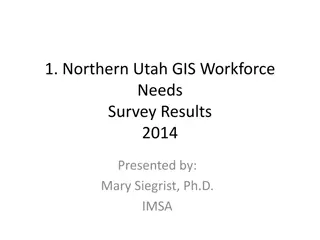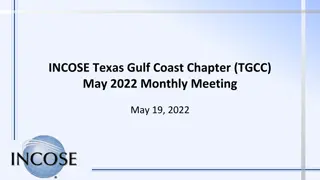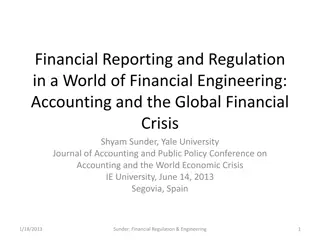Survey on ESEF Financial Reporting Requirements - May 2022
A collaborative survey between Aalto University School of Business, XBRL Finland, and the Finnish Financial Supervisory Authority aimed to assess the current state of XBRL implementation in Finnish issuers impacted by ESEF reporting requirements. The survey conducted in May 2022 received 26 responses out of 145 Finnish issuers, providing insights on industry sectors, listing segments, and issuer opinions on XBRL and ESEF reporting. The findings compared responses from 2019 to 2022.
Download Presentation

Please find below an Image/Link to download the presentation.
The content on the website is provided AS IS for your information and personal use only. It may not be sold, licensed, or shared on other websites without obtaining consent from the author.If you encounter any issues during the download, it is possible that the publisher has removed the file from their server.
You are allowed to download the files provided on this website for personal or commercial use, subject to the condition that they are used lawfully. All files are the property of their respective owners.
The content on the website is provided AS IS for your information and personal use only. It may not be sold, licensed, or shared on other websites without obtaining consent from the author.
E N D
Presentation Transcript
Survey on ESEF (European Single Electronic Format) financial reporting requirements (xHTML and iXBRL), May 2022
Survey The survey was conducted in collaboration between Aalto University School of Business, XBRL Finland and the Finnish Financial Supervisory Authority. The aim of the survey was to probe the current state of XBRL implementation in Finnish issuers that are impacted by the ESEF reporting requirements. This survey is a follow-up survey to similar studies made in April 2021, April 2020 and April 2019. The survey included background questions, questions on the current stage of implementation, questions concerning the choice of deployment model, and questions on issuers opinions regarding XBRL and the ESEF reporting requirements. The survey was conducted in May 2022. The survey was sent to 145 Finnish issuers and 26 responses were received, yielding a response rate of 18%. The following slides report the findings of the survey and make a comparison between the responses given by the issuers in 2019, 2020, 2021, and 2022. The survey was administered by Esko Penttinen from Aalto University (esko.penttinen@aalto.fi).
1. In what industry does your company operate in? Number of respondents: 26 Oil& Gas Basic Materials Industrials 35% Consumer Services 4% Consumer Goods 11% Health Care, Financials 4% Technology 15% Telecommunications Utilities 4% Other, please specify: 27% 0% 5% 10% 15% 20% 25% 30% 35% 40%
1. In what industry does your company operate in? Number of respondents: 26 n Prosentti Oil& Gas 0 0,0% Basic Materials 0 0,0% Industrials 9 34,6% Consumer Services 1 3,9% Consumer Goods 3 11,5% Health Care, Financials 1 3,9% Technology 4 15,4% Telecommunications 0 0,0% Utilities 1 3,8% Other, please specify: 7 26,9%
2. In what segment are you listed? Number of respondents: 26 Large Cap companies with a share value over EUR 1 billion 35% Mid Cap companies with a share value exceeding EUR 150 million but not more than EUR 1 billion 23% Small Cap companies with a share value up to EUR 150 million 42% 0% 5% 10%15%20%25%30%35%40%45%
2. In what segment are you listed? Number of respondents: 26 n Prosentti Large Cap companies with a share value over EUR 1 billion 9 34,6% Mid Cap companies with a share value exceeding EUR 150 million but not more than EUR 1 billion 6 23,1% Small Cap companies with a share value up to EUR 150 million 11 42,3%
3. What is your role? Number of respondents: 26 CFO 19% Head of financial reporting 35% Other, please specify: 46% 0% 10% 20% 30% 40% 50%
3. What is your role? Number of respondents: 26 n Prosentti CFO 5 19,2% Head of financial reporting 9 34,6% Other, please specify: 12 46,2%
4. Please indicate when you started to submit your financial statements according to the ESEF financial reporting requirements (i.e., in XBRL format)? Number of respondents: 26 We did our first financial statements based on ESEF financial reporting requirements this Spring (for financial year 2021) 38% We did our financial statements based on ESEF financial reporting requirements already last Spring (voluntary filing for financial year 2020) 62% We have not been able to submit financial statements according to the ESEF financial reporting requirements / We have not yet been obliged to submit financial statements according to the ESEF reporting requirements 0% 10% 20% 30% 40% 50% 60% 70%
4. Please indicate when you started to submit your financial statements according to the ESEF financial reporting requirements (i.e., in XBRL format)? Number of respondents: 26 n Prosentti We did our first financial statements based on ESEF financial reporting requirements this Spring (for financial year 2021) 10 38,5% We did our financial statements based on ESEF financial reporting requirements already last Spring (voluntary filing for financial year 2020) 16 61,5% We have not been able to submit financial statements according to the ESEF financial reporting requirements / We have not yet been obliged to submit financial statements according to the ESEF reporting requirements 0 0,0%
5. Please indicate how you implemented the ESEF financial reporting requirements (for potentially unclear vocabulary, consult e.g. https://www.xbrl.org/the-standard/how/getting-started-for-business/) Number of respondents: 26 We used our existing financial reporting system which was made compliant with iXBRL / ESEF requirements (A) We used an external XBRL-compliant reporting tool as a "bolt on" (B) We tagged notes to the financial statements (not required by ESEF in 2021 statements) (A) We did not tag notes but only primary financial statements (ESEF-minimum requirement for 2021) (B) We plan to tag notes to the financial statements using block tagging for 2022 financial statements (B) We plan to tag notes to the financial statements at a granular level for 2022 financial statements (A) Going forward, we would be willing to extend XBRL reporting to quarterly and/or half-year reports (in addition to the annual financial statements) (A) Going forward, we would not be willing to extend XBRL reporting to quarterly and/or half-year reports (in addition to the annual financial statements) (B) Now that ESEF is implemented in consolidated accounts, we would be willing extend ESEF XBRL reporting to parent company's separate accounts (according to local GAAP or IFRS) (A) Now that ESEF is implemented in consolidated accounts, we would not be willing extend ESEF XBRL reporting to parent company's separate accounts (according to local GAAP or IFRS) (B) Going forward, we would be willing to extend XBRL reporting to the subsidiaries' and parent companies' reporting to local business registers (A) Going forward, we would not be willing to extend XBRL reporting to the subsidiaries' and parent companies' reporting to local business registers (B) Going forward, we would be willing to extend XBRL reporting to narrative reports (e.g., management report) (A) Going forward, we would not be willing to extend XBRL reporting to narrative reports (e.g., management report) (B) Going forward, we would be willing to extend XBRL reporting to ESG (Environmental, Social, and Governance) reports (A) Going forward, we would not be willing to extend XBRL reporting to ESG (Environmental, Social, and Governance) reports (B) 0% 20% 40% 60% 80% 100% Option (A) Option (B)
5. Please indicate how you implemented the ESEF financial reporting requirements (for potentially unclear vocabulary, consult e.g. https://www.xbrl.org/the-standard/how/getting-started-for-business/) Number of respondents: 26 Option (A) Option (B) Yhteens Keskiarvo Mediaani We used our existing financial reporting system which was made compliant with iXBRL / ESEF requirements (A) 7 19 We used an external XBRL-compliant reporting tool as a "bolt on" (B) 26 1,7 2,0 26,9% 73,1% We tagged notes to the financial statements (not required by ESEF in 2021 statements) (A) 0 25 We did not tag notes but only primary financial statements (ESEF-minimum requirement for 2021) (B) 25 2,0 2,0 0,0% 100,0% We plan to tag notes to the financial statements at a granular level for 2022 financial statements (A) 4 20 We plan to tag notes to the financial statements using block tagging for 2022 financial statements (B) 24 1,8 2,0 16,7% 83,3%
Option (A) Option (B) Yhteens Keskiarvo Mediaani Going forward, we would be willing to extend XBRL reporting to quarterly and/or half-year reports (in addition to the annual financial statements) (A) 3 22 Going forward, we would not be willing to extend XBRL reporting to quarterly and/or half-year reports (in addition to the annual financial statements) (B) 25 1,9 2,0 12,0% 88,0% Now that ESEF is implemented in consolidated accounts, we would be willing extend ESEF XBRL reporting to parent company's separate accounts (according to local GAAP or IFRS) (A) 2 22 Now that ESEF is implemented in consolidated accounts, we would not be willing extend ESEF XBRL reporting to parent company's separate accounts (according to local GAAP or IFRS) (B) 24 1,9 2,0 8,3% 91,7% Going forward, we would be willing to extend XBRL reporting to the subsidiaries' and parent companies' reporting to local business registers (A) 1 20 Going forward, we would not be willing to extend XBRL reporting to the subsidiaries' and parent companies' reporting to local business registers (B) 21 2,0 2,0 4,8% 95,2%
Option (A) Option (B) Yhteens Keskiarvo Mediaani Going forward, we would be willing to extend XBRL reporting to narrative reports (e.g., management report) 0 24 Going forward, we would not be willing to extend XBRL reporting to narrative reports (e.g., management report) (B) 24 2,0 2,0 0,0% 100,0% (A) Going forward, we would be willing to extend XBRL reporting to ESG (Environmental, Social, and Governance) reports 4 21 Going forward, we would not be willing to extend XBRL reporting to ESG (Environmental, Social, and Governance) reports (B) 25 1,8 2,0 16,0% 84,0% (A) Yhteens 21 173 194 1,9 2,0
6. Please indicate how you implemented the ESEF financial reporting requirements (for potentially unclear vocabulary, consult e.g. https://www.xbrl.org/the-standard/how/getting-started-for-business/) Number of respondents: 26 We developed and accrued competencies regarding the ESEF reporting requirements in-house (e.g. xHTML and knowledge on iXBRL taxonomies) (A) We relied on outsourcing service provider s competencies on the ESEF reporting requirements (e.g. xHTML and knowledge on iXBRL taxonomies) (B) We did the tagging of our financial statements to the ESEF taxonomy in- house (A) We outsourced the tagging of our financial statements to the ESEF taxonomy (B) 0% 20% 40% 60% 80% 100% Option (A) Hybrid Option (B)
6. Please indicate how you implemented the ESEF financial reporting requirements (for potentially unclear vocabulary, consult e.g. https://www.xbrl.org/the-standard/how/getting-started-for-business/) Number of respondents: 26 Option (A) Hybrid Option (B) Yhteens Keskiarvo Mediaani We developed and 4 14 8 We relied on outsourcing service provider s competencies on the ESEF reporting requirements (e.g. xHTML and knowledge on iXBRL taxonomies) (B) 26 2,2 2,0 accrued 15,4% 53,8% 30,8% competencies regarding the ESEF reporting requirements in- house (e.g. xHTML and knowledge on iXBRL taxonomies) (A) We did the tagging of our financial statements to the ESEF taxonomy in-house (A) 13 4 9 We outsourced the tagging of our financial statements to the ESEF taxonomy (B) 26 1,8 1,5 50,0% 15,4% 34,6% Yhteens 17 18 17 52 2,0 2,0
7. Please indicate whether an independent auditor provided assurance on your ESEF financial statements for the year 2021 Number of respondents: 26 Our own auditor has issued an assurance report on ESEF Financial Statements for the year 2021 85% Other independent auditor has issued an assurance report on ESEF financial statements for the year 2021 No assurance report was issued on ESEF financial statements for the year 2021 15% 0% 10%20%30%40%50%60%70%80%90%
7. Please indicate whether an independent auditor provided assurance on your ESEF financial statements for the year 2021 Number of respondents: 26 n Prosentti Our own auditor has issued an assurance report on ESEF Financial Statements for the year 2021 22 84,6% Other independent auditor has issued an assurance report on ESEF financial statements for the year 2021 0 0,0% No assurance report was issued on ESEF financial statements for the year 2021 4 15,4%
8. Please indicate on a scale (1 = do not agree ... 5 = agree), your opinion on the following statements regarding ESEF and XBRL Number of respondents: 26 Keskiarvo 3,2 n = 26 It is difficult to find expertise on XBRL in Finland 2,6 n = 25 It is difficult to find expertise on XBRL globally 2,9 n = 26 Our company has employees knowledgeable on XBRL 3,0 n = 26 I am knowledgeable on XBRL Implementing ESEF and XBRL requires considerable investments in IT resources from companies Implementing ESEF and XBRL requires deep knowledge of XBRL from companies Implementing ESEF and XBRL requires deep knowledge of IFRS from companies 3,1 n = 26 3,4 n = 26 3,8 n = 26 3,4 n = 25 Implementing ESEF and XBRL incurs considerable costs to companies 3,2 n = 26 Companies should have a deep knowledge of ESEF/XBRL taxonomy Quality of the financial statements tagged with XBRL will suffer if XBRL- tags are not audited ESEF will speed up the process of transmitting data on financial statements to users 3,6 n = 26 2,6 n = 26 3,0 n = 26 ESEF will improve the usefulness of financial statements 2,8 n = 24 ESEF will improve the reliability of financial statements n = 26 3,2 ESEF will improve the comparability of financial statements Our company is prepared for tagging of notes (which will start in 2023 for 2022 financial statements) Implementing tagging of notes (which will start in 2023 for 2022 financial statements) will require considerable effort n = 26 3,2 n = 25 3,7 0 1 2 3 4 5
8. Please indicate on a scale (1 = do not agree ... 5 = agree), your opinion on the following statements regarding ESEF and XBRL Number of respondents: 26 1 2 3 4 5 Keskiarvo Mediaani It is difficult to find expertise on XBRL in Finland 7,7% 11,5% 42,3% 34,6% 3,9% 3,2 3,0 It is difficult to find expertise on XBRL 20,0% 20,0% 40,0% 16,0% 4,0% 2,6 3,0 globally Our company has employees knowledgeable on 15,4% 15,4% 30,8% 38,4% 0,0% 2,9 3,0 XBRL I am 11,6% 19,2% 34,6% 26,9% 7,7% 3,0 3,0 knowledgeable on XBRL Implementing ESEF and XBRL requires considerable investments in IT resources from companies 11,5% 23,1% 30,8% 15,4% 19,2% 3,1 3,0
1 2 3 4 5 Keskiarvo Mediaani Implementing ESEF and XBRL requires deep knowledge of XBRL from companies 0,0% 30,8% 19,2% 30,8% 19,2% 3,4 3,5 Implementing ESEF and XBRL requires deep knowledge of IFRS from companies 0,0% 11,5% 19,2% 46,2% 23,1% 3,8 4,0 Implementing ESEF and XBRL 0,0% 16,0% 48,0% 20,0% 16,0% 3,4 3,0 incurs considerable costs to companies Companies should have a deep knowledge of ESEF/XBRL taxonomy 7,7% 19,2% 19,2% 50,0% 3,9% 3,2 4,0 Quality of the financial statements tagged with XBRL will suffer if XBRL- tags are not 7,7% 15,4% 11,5% 38,5% 26,9% 3,6 4,0 audited
1 2 3 4 5 Keskiarvo Mediaani ESEF will speed up the process of transmitting data on financial statements to 23,1% 23,1% 26,9% 26,9% 0,0% 2,6 3,0 users ESEF will improve the usefulness of 11,5% 15,4% 30,8% 42,3% 0,0% 3,0 3,0 financial statements ESEF will improve the reliability of 16,6% 16,7% 45,8% 16,7% 4,2% 2,8 3,0 financial statements ESEF will improve the comparability of financial statements 7,7% 15,4% 38,5% 26,9% 11,5% 3,2 3,0 Our company is prepared for tagging of notes (which will start in 2023 for 2022 7,7% 23,1% 34,6% 15,4% 19,2% 3,2 3,0 financial statements)
1 2 3 4 5 Keskiarvo Mediaani Implementing tagging of notes (which will start in 2023 for 2022 4,0% 12,0% 24,0% 32,0% 28,0% 3,7 4,0 financial statements) will require considerable effort
5. Please indicate how you plan to implement the ESEF financial reporting requirements (for potentially unclear vocabulary, consult e.g. https://www.xbrl.org/the-standard/how/getting- started-for-business/) 2019 Number of respondents: 21 We plan to rely on outsourcing service provider s competencies on the ESEF reporting requirements (e.g. xHTML and knowledge on iXBRL taxonomies) (B) We plan to develop and accrue competencies regarding the ESEF reporting requirements in- house (e.g. xHTML and knowledge on iXBRL taxonomies) (A) We plan to do the tagging of our financial statements to the ESEF taxonomy in-house (A) We plan to outsource the tagging of our financial statements to the ESEF taxonomy (B) We plan to use our existing financial reporting system which will be made compliant with iXBRL / ESEF requirements (A) We plan to use an external XBRL compliant reporting tool as a "bolt on" (B) We plan to use block tagging (ESEF-minimum requirement) to notes (B) We plan to tag notes to the financial statements at a granular level (not required by ESEF) (A) Once ESEF implemented,we would be willing to extend XBRL reporting to quarterly and/or half- year reports (in addition to the annual financial statement) (A) Once ESEF implemented,we would not be willing to extend XBRL reporting to quarterly and/or half-year reports (in addition to the annual financial statement) (B) Once ESEF implemented, we would be willing to extend XBRL reporting to narrative reports (e.g. management report) (A) Once ESEF implemented, we would not be willing to extend XBRL reporting to narrative reports (e.g. management report) (B) 0% 20% 40% 60% 80% 100% Option (A) Not yet decided
5. Please indicate how you plan to implement the ESEF financial reporting requirements (for potentially unclear vocabulary, consult e.g. https://www.xbrl.org/the-standard/how/getting- started-for-business/) 2020 Number of respondents: 17 We plan to rely on outsourcing service provider s competencies on the ESEF reporting requirements (e.g. xHTML and knowledge on iXBRL taxonomies) (B) We plan to develop and accrue competencies regarding the ESEF reporting requirements in-house (e.g. xHTML and knowledge on iXBRL taxonomies) (A) We plan to do the tagging of our financial statements to the ESEF taxonomy in-house (A) We plan to outsource the tagging of our financial statements to the ESEF taxonomy (B) We plan to use our existing financial reporting system which will be made compliant with iXBRL / ESEF requirements (A) We plan to use an external XBRL compliant reporting tool as a "bolt on" (B) We plan to tag notes to the financial statements at a granular level (not required by ESEF) (A) We plan to use block tagging (ESEF-minimum requirement) to notes (B) Once ESEF implemented,we would be willing to extend XBRL reporting to quarterly and/or half-year reports (in addition to the annual financial statements) (A) Once ESEF implemented,we would not be willing to extend XBRL reporting to quarterly and/or half-year reports (in addition to the annual financial statements) (B) Once ESEF implemented in consolidated accounts, we would not be willing to extend ESEF XBRL reporting to parent company s separate accounts (according to local GAAP or IFRS). (B) Once ESEF implemented in consolidated accounts, we would be willing to extend ESEF XBRL reporting to parent company s separate accounts (according to local GAAP or IFRS). (A) Once ESEF implemented, we would be willing to extend XBRL reporting to the subsidiaries' and parent companies' reporting to local business registers. (A) Once ESEF implemented, we would not be willing to extend XBRL reporting to the subsidiaries' and parent companies' reporting to local business registers. (B) Once ESEF implemented, we would be willing to extend XBRL reporting to narrative reports (e.g. management report) (A) Once ESEF implemented, we would not be willing to extend XBRL reporting to narrative reports (e.g. management report) (B) 0% 10% 20% 30% 40% 50% 60% 70% 80% 90% 100% Option (A) Not yet decided Option (B)
5. Please indicate how you plan to implement the ESEF financial reporting requirements (for potentially unclear vocabulary, consult e.g. https://www.xbrl.org/the-standard/how/getting-started-for-business/) 2021 Number of respondents: 27 We plan to develop and accrue competencies regarding the ESEF reporting requirements in-house (e.g. xHTML and knowledge on iXBRL taxonomies) (A) We plan to rely on outsourcing service provider s competencies on the ESEF reporting requirements (e.g. xHTML and knowledge on iXBRL taxonomies) (B) We plan to do the tagging of our financial statements to the ESEF taxonomy in-house (A) We plan to outsource the tagging of our financial statements to the ESEF taxonomy (B) We plan to use our existing financial reporting system which will be made compliant with iXBRL / ESEF requirements (A) We plan to use an external XBRL compliant reporting tool as a "bolt on" (B) We plan to use block tagging (ESEF-minimum requirement) to notes (B) We plan to tag notes to the financial statements at a granular level (not required by ESEF) (A) Once ESEF implemented,we would not be willing to extend XBRL reporting to quarterly and/or half-year reports (in addition to the annual financial statements) (B) Once ESEF implemented,we would be willing to extend XBRL reporting to quarterly and/or half-year reports (in addition to the annual financial statements) (A) Once ESEF implemented in consolidated accounts, we would not be willing to extend ESEF XBRL reporting to parent company s separate accounts (according to local GAAP or IFRS). (B) Once ESEF implemented, we would not be willing to extend XBRL reporting to the subsidiaries' and parent companies' reporting to local business registers. (B) Once ESEF implemented in consolidated accounts, we would be willing to extend ESEF XBRL reporting to parent company s separate accounts (according to local GAAP or Once ESEF implemented, we would be willing to extend XBRL reporting to the subsidiaries' and parent companies' reporting to local business registers. (A) Once ESEF implemented, we would be willing to extend XBRL reporting to narrative reports (e.g. management report) (A) Once ESEF implemented, we would not be willing to extend XBRL reporting to narrative reports (e.g. management report) (B) Our company filed the 2020 annual financial statement according to the ESEF requirements (A) Our company filed the 2020 annual financial statement in PDF (as before) (B) 0% 20% 40% 60% 80% 100% Option (A) Not yet decided Option (B)
2022 5. Please indicate how you implemented the ESEF financial reporting requirements (for potentially unclear vocabulary, consult e.g. https://www.xbrl.org/the-standard/how/getting-started-for-business/) Number of respondents: 26 We used our existing financial reporting system which was made compliant with iXBRL / ESEF requirements (A) We used an external XBRL-compliant reporting tool as a "bolt on" (B) We tagged notes to the financial statements (not required by ESEF in 2021 statements) (A) We did not tag notes but only primary financial statements (ESEF-minimum requirement for 2021) (B) We plan to tag notes to the financial statements using block tagging for 2022 financial statements (B) We plan to tag notes to the financial statements at a granular level for 2022 financial statements (A) Going forward, we would be willing to extend XBRL reporting to quarterly and/or half-year reports (in addition to the annual financial statements) (A) Going forward, we would not be willing to extend XBRL reporting to quarterly and/or half-year reports (in addition to the annual financial statements) (B) Now that ESEF is implemented in consolidated accounts, we would be willing extend ESEF XBRL reporting to parent company's separate accounts (according to local GAAP or IFRS) (A) Now that ESEF is implemented in consolidated accounts, we would not be willing extend ESEF XBRL reporting to parent company's separate accounts (according to local GAAP or IFRS) (B) Going forward, we would be willing to extend XBRL reporting to the subsidiaries' and parent companies' reporting to local business registers (A) Going forward, we would not be willing to extend XBRL reporting to the subsidiaries' and parent companies' reporting to local business registers (B) Going forward, we would be willing to extend XBRL reporting to narrative reports (e.g., management report) (A) Going forward, we would not be willing to extend XBRL reporting to narrative reports (e.g., management report) (B) Going forward, we would be willing to extend XBRL reporting to ESG (Environmental, Social, and Governance) reports (A) Going forward, we would not be willing to extend XBRL reporting to ESG (Environmental, Social, and Governance) reports (B) 0% 20% 40% 60% 80% 100% Option (A) Option (B)
2022 6. Please indicate how you implemented the ESEF financial reporting requirements (for potentially unclear vocabulary, consult e.g. https://www.xbrl.org/the-standard/how/getting-started-for-business/) Number of respondents: 26 We developed and accrued competencies regarding the ESEF reporting requirements in-house (e.g. xHTML and knowledge on iXBRL taxonomies) (A) We relied on outsourcing service provider s competencies on the ESEF reporting requirements (e.g. xHTML and knowledge on iXBRL taxonomies) (B) We did the tagging of our financial statements to the ESEF taxonomy in- house (A) We outsourced the tagging of our financial statements to the ESEF taxonomy (B) 0% 20% 40% 60% 80% 100% Option (A) Hybrid Option (B)
6. Please indicate on a scale (1 = do not agree ... 5 = agree), your opinion on the following statements regarding ESEF and XBRL 2019 Number of respondents: 21 Keskiarvo 3,3 It is difficult to find expertise on XBRL in Finland 2,6 It is difficult to find expertise on XBRL globally 2,1 Our company has employees knowledgeable on XBRL 2,0 I am knowledgeable on XBRL 3,0 Implementing ESEF and XBRL requires considerable investments in IT resources from companies 3,3 Implementing ESEF and XBRL requires deep knowledge of XBRL from companies 3,7 Implementing ESEF and XBRL requires deep knowledge of IFRS from companies 3,4 Implementing ESEF and XBRL incurs considerable costs to companies 3,6 Companies should have a deep knowledge of ESEF/XBRL taxonomy 3,3 Quality of the financial statements tagged with XBRL will suffer if XBRL-tags are not audited 0 1 2 3 4 5
6. Please indicate on a scale (1 = do not agree ... 5 = agree), your opinion on the following statements regarding ESEF and XBRL 2020 Number of respondents: 18 Keski arvo 2,6 It is difficult to find expertise on XBRL in Finland n = 18 2,3 It is difficult to find expertise on XBRL globally n = 18 2,9 Our company has employees knowledgeable on XBRL n = 18 2,7 I am knowledgeable on XBRL n = 18 Implementing ESEF and XBRL requires considerable investments in IT resources from companies Implementing ESEF and XBRL requires deep knowledge of XBRL from companies Implementing ESEF and XBRL requires deep knowledge of IFRS from companies Implementing ESEF and XBRL incurs considerable costs to companies Companies should have a deep knowledge of ESEF/XBRL taxonomy Quality of the financial statements tagged with XBRL will suffer if XBRL-tags are not audited ESEF will speed up the process of transmitting data on financial statements to users 2,9 n = 18 2,8 n = 18 3,2 n = 18 3,1 n = 18 3,3 n = 17 2,7 n = 18 2,8 n = 18 3,1 ESEF will improve the usefulness of financial statements n = 18 2,2 ESEF will improve the reliability of financial statements n = 18 3,4 ESEF will improve the comparability of financial statements n = 18 0 1 2 3 4 5
6. Please indicate on a scale (1 = do not agree ... 5 = agree), your opinion on the following statements regarding ESEF and XBRL 2021 Number of respondents: 27 Keskiarvo n = 27 It is difficult to find expertise on XBRL in Finland 2,7 n = 26 It is difficult to find expertise on XBRL globally 2,3 n = 27 Our company has employees knowledgeable on XBRL 3,0 n = 27 2,8 I am knowledgeable on XBRL Implementing ESEF and XBRL requires considerable investments in IT resources from companies n = 27 2,4 Implementing ESEF and XBRL requires deep knowledge of XBRL from companies n = 27 3,0 Implementing ESEF and XBRL requires deep knowledge of IFRS from companies n = 27 3,6 Implementing ESEF and XBRL incurs considerable costs to companies n = 27 2,9 n = 27 Companies should have a deep knowledge of ESEF/XBRL taxonomy 3,1 Quality of the financial statements tagged with XBRL will suffer if XBRL-tags are not audited n = 27 3,5 ESEF will speed up the process of transmitting data on financial statements to users n = 27 2,8 n = 27 ESEF will improve the usefulness of financial statements 3,0 n = 27 ESEF will improve the reliability of financial statements 2,5 n = 27 3,0 ESEF will improve the comparability of financial statements 0 1 2 3 4 5
2022 8. Please indicate on a scale (1 = do not agree ... 5 = agree), your opinion on the following statements regarding ESEF and XBRL Number of respondents: 26 Keskiarvo 3,2 n = 26 It is difficult to find expertise on XBRL in Finland 2,6 n = 25 It is difficult to find expertise on XBRL globally 2,9 n = 26 Our company has employees knowledgeable on XBRL 3,0 n = 26 I am knowledgeable on XBRL Implementing ESEF and XBRL requires considerable investments in IT resources from companies Implementing ESEF and XBRL requires deep knowledge of XBRL from companies Implementing ESEF and XBRL requires deep knowledge of IFRS from companies 3,1 n = 26 3,4 n = 26 3,8 n = 26 3,4 n = 25 Implementing ESEF and XBRL incurs considerable costs to companies 3,2 n = 26 Companies should have a deep knowledge of ESEF/XBRL taxonomy Quality of the financial statements tagged with XBRL will suffer if XBRL- tags are not audited ESEF will speed up the process of transmitting data on financial statements to users 3,6 n = 26 2,6 n = 26 3,0 n = 26 ESEF will improve the usefulness of financial statements 2,8 n = 24 ESEF will improve the reliability of financial statements n = 26 3,2 ESEF will improve the comparability of financial statements Our company is prepared for tagging of notes (which will start in 2023 for 2022 financial statements) Implementing tagging of notes (which will start in 2023 for 2022 financial statements) will require considerable effort n = 26 3,2 n = 25 3,7 0 1 2 3 4 5
Observations on trends 2019 -> 2020 -> 2021 -> 2022 Deployment pressure can be seen in the latest survey results Respondents find that it is somewhat difficult to find expertise on XBRL in Finland in 2022 (3,2) compared to 2,7 (2021) and 2,6 (2020) and 3,3 (2019); issuers have employees knowledgeable on XBRL (2,1 -> 2,9 -> 3,0 -> 2,9) Perceptions about incurred costs bounced back to where they were in 2019 (3,4 -> 3,1 -> 2,9 -> 3,4). Steady progression towards completion of ESEF project as all respondents declared that they were able to submit their financial statements (compared to 2021 when 74% of respondents had completed their ESEF project, 26% had selected the deployment model but project not yet complete). Regarding deployment model Balance between outsourcing and in-house development: tagging close to 50 (in-house)/50 (outsourced) Bolt-on preferred over integrated at 73% in the latest survey Voluntarily extending XBRL reporting Respondents indicated that their companies opt for the minimum requirements. Sixteen percent of respondents would be willing to extend XBRL to ESG reporting. Benefits of XBRL Perceptions about the improvements to financial statements comparability (3,4 -> 3,0 -> 3,2) and usefulness (3,1 -> 3,0 -> 3,0) have remained roughly the same over the surveys. Companies increasingly feel that XBRL could improve reliability of financial reporting (2,2 -> 2,5 -> 2,8).
